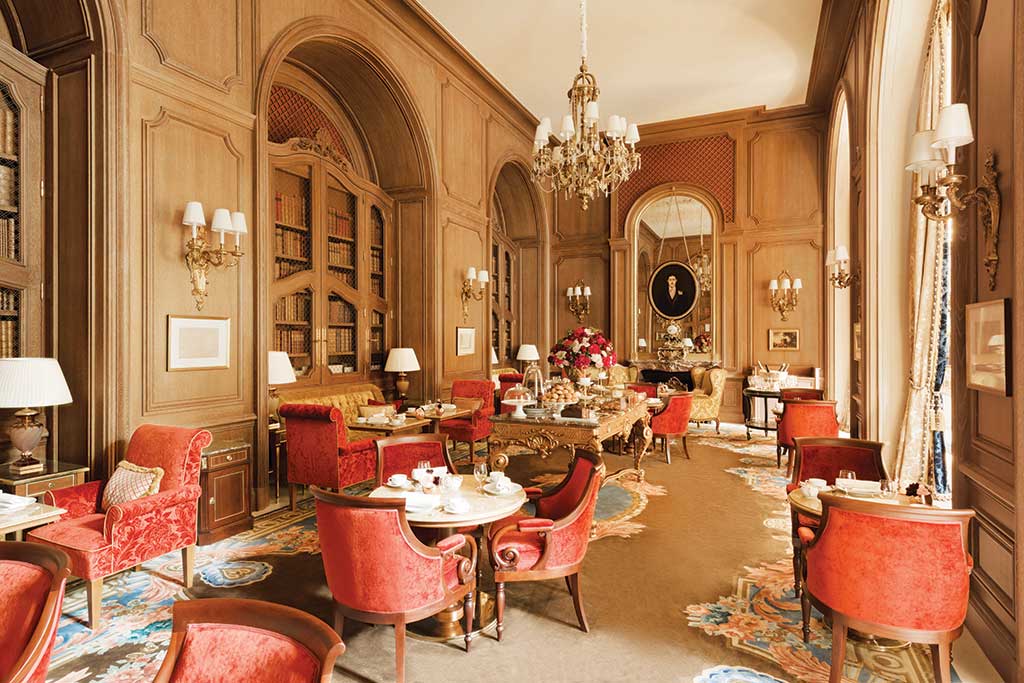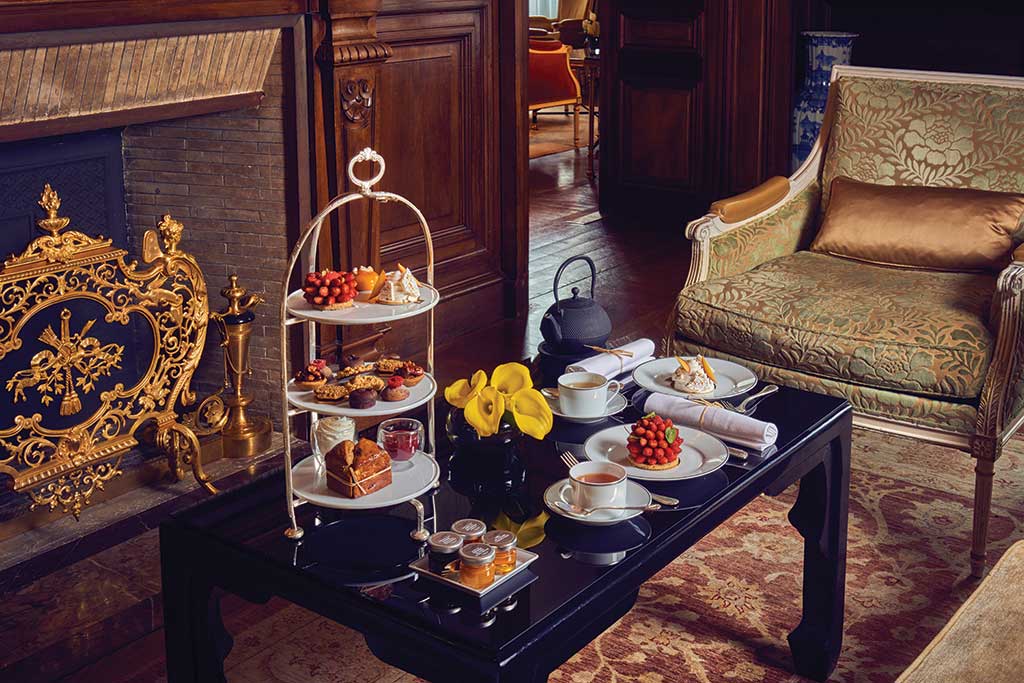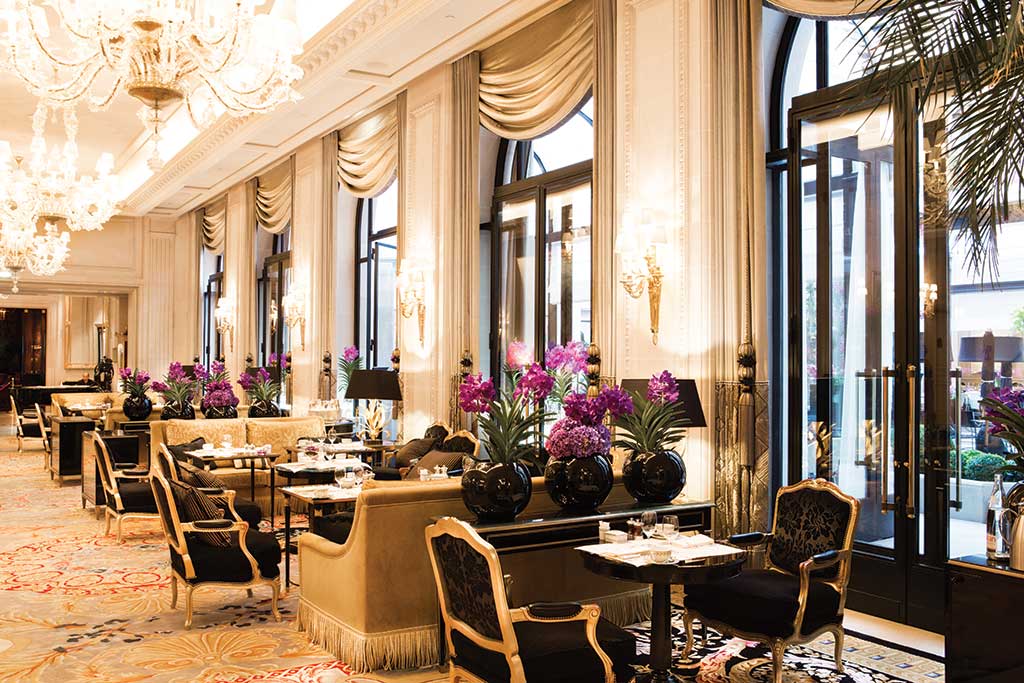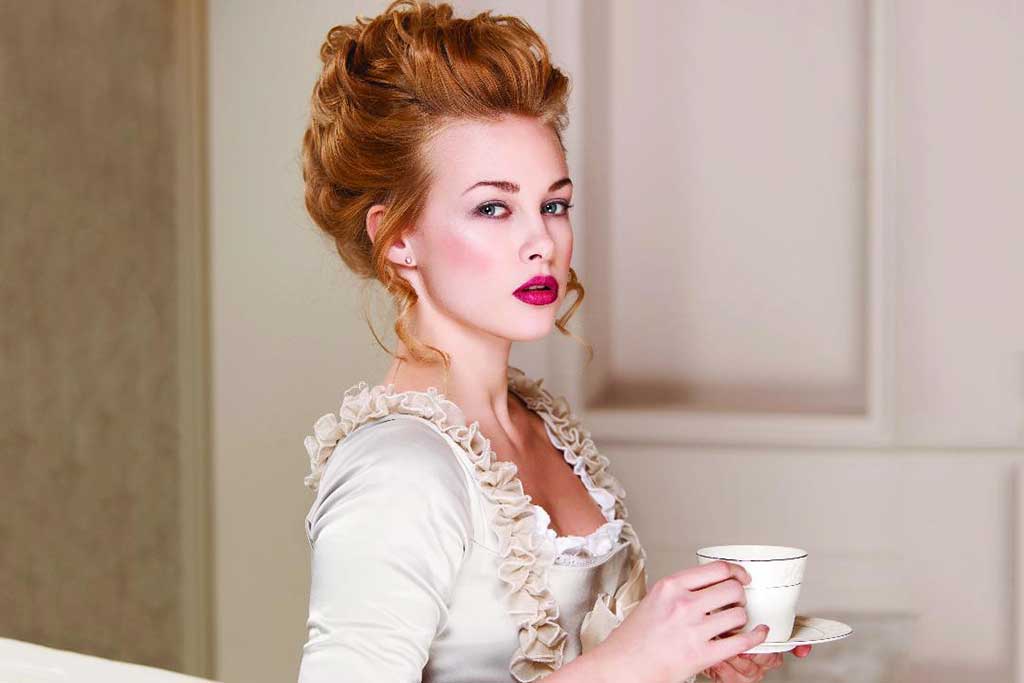Join Richard Nayhem as he explores tea time in Paris, in search of the best High Tea.
One doesn’t usually associate Paris with tea or tea salons. It’s the city that invented the café culture hundreds of years ago with endless cafés lining the streets and boulevards, where Parisians famously sip espresso hours on end, watching people and life go by. The pinnacle of the Paris café was from the 1920s to the 1950s when Les Deux Magots and Café de Flore in Saint-Germain-des-Prés were a haven for artists, writers, and poets such as Ernest Hemingway, F . Scott Fitzgerald, Pablo Picasso, Albert Camus, James Joyce, Jean-Paul Sartre, and Simone de Beauvoir.
Tea has always played a poor cousin to coffee in France even though it arrived in 1636, 50 years before coffee. Imported from China and Japan, tea was popularized by the aristocracy starting with Cardinal Jules Mazarin, a French statesman who drank tea to cure his gout. It apparently worked because Louis XIV , the Sun King, began drinking tea in 1665 because he learned the Chinese and Japanese rarely had heart disease. He lived till the ripe age 77, a miracle for that time.
In 1692 King Louis XIV granted François Damame the exclusive privilege of selling tea in France and the first tea brand was born, now called Dammann Freres. Fast forward to 2017, Dammann Frères is now owned by Illy Group with a flagship boutique on the historic Place des Vosges that sells hundreds of tea flavors plus teapots, gift sets, and teacups.
Ladurée on Rue Royale, the maker of the most popular French macaron, was also the location of the first tea salon in Paris.
In the early 1900s the rise of tearooms in England as a place where women could gather during the day without a male accompanying them prompted Ernest Laduree’s wife Jeanne Suchard to petition her husband to open a tea salon in Paris. Today high tea is a staple at luxury hotels around town, and we recently visited three of the five-star palace hotels to experience what they had to offer.

Ritz Paris, Salon Proust
HÔTEL RITZ PARIS
One new delight of the recent renovation of Hôtel Ritz Paris in 2016 is the addition of the Salon Proust, a lounge and tearoom named in honor of Marcel Proust, a longstanding guest at the hotel. Proust’s elegant lifestyle is exemplified in the salon with a library of books behind polished wood doors, plush lounges, and club chairs, intimate sconces, a marble mantle with a roaring fire below, and an oval oil portrait of handsome and mustached Proust.
A 17-page tea menu, resembling a volume of the encyclopedia, offers over 20 selections of tea, a feast even for the most discerning tea aficionado. The selection includes black, green, white, fermented, and herbal from India, China, and South Africa. The dreamy looking pastry chef, Francois Perret, prepares more than an over-the-top menu of pastries. A departure from classic English high tea of finger sandwiches and scones with clotted cream, Perret’s menu offers sweet things only.
The service begins with a peculiar ritual where the waiter serves a madeleine in a bowl and then pours fresh cream over it. Next up is the traditional multi-tiered silver tray decorated with delectable pastries: a cookie resembling a Pepperidge Farm Milano, a pretty-pink meringue, wafers with cream, a gingerbread man stuffed with marshmallow, delicate butter cookies, paper-thin almond tuiles, and chocolate-infused bread.
When you ask for l’addition when you are finished, it’s presented inside a burgundy leather-bound book by Proust. The piece de resistance is a memorable keepsake to cherish the experience: a mini-tin filled with tea packaged in a blue box embossed with an illustration of the hotel. High tea served 2:30 P.M. to 6 P.M. daily. €65 per person. www.ritzparis.com/en-gb/salon-proust

Afternoon Tea at Shangri-La
SHANGRI-LA HOTEL, PARIS
Built in 1896 as a private mansion for Prince Roland Bonaparte, an explorer, geographer, botanist, and the grandson Lucien Bonaparte, the younger brother of Napoleon Bonaparte, the Shangri-La Hotel is obviously steeped in history. The 215,000-foot structure took over four years to renovate, lead by architect Richard Martinet and interior designer Pierre-Yves Rochon. Retaining many of the original interior and exterior elements, the varied architectural style includes Louis XIV , Empire, and Greco-Roman periods with carvings and sculptures by Steiner and Houguenade, who worked on the Tulieries Palace and the Louvre.
The lobby lounges on both sides of the grand entrance hall of the hotel have a series of intimate nooks decorated in combination of Asian and classic French style with sofas, club chairs, and ottomans, silk walls, and crystal chandeliers. In an effort to set its self apart from the standard high tea at other hotels, The Shangri-La has the only vegan high-tea service in Paris.
I arrived with a bit of trepidation, as I wasn’t sure what to expect. Would the chef be able to make the same type of sumptuous pastries with same taste I had at other hotels with such limitations? The answer is a resounding and surprising yes! Apple and raisin scones tied in straw are dense and delicious and served with whipped cream so authentic, I grilled the waiter on what exactly was in it, because I refused to believe it was made with anything else but heavy cream. A selection of tartlets of nuts, meringues, and chocolate were outstanding, but not too rich or gooey.
A white porcelain plate was set down on our table with three stunning pastries: pastry cream with butter cookie crust, vanilla pastry cream, strawberry marmalade all enrobed in a circle of organic strawberries, a chocolate and salt shortbread with caramel mousse and soft chocolate interior, and, lastly, a pavlova with meringue, jasmine-scented pastry cream, and poached pomelos with vanilla.
What astonished us were the tastes of the pastries were as good or if not better than how they looked. There was no gummy or weird after-taste like so many disappointing desserts we’ve had at vegan restaurants. Pastry chef Michael Bartocetti has pulled off the ultimate culinary feat by creating an almost guilt-free experience.
A vast menu specializing in Asian tea includes three black Grand Cru selections from Ceylon: Ran Watte with notes of peach and citrus, Uda Watte with notes of hazel-nuts, almonds, dried fruits, and caramel; Meda Watte with notes of caramel, figs, and thyme; and Yata Watte, with notes of bay leaf, spices and dried apricot. 3 P.M.-6 P.M. €45 per person. www.shangrila.com/paris/shangril

George V, La Galerie
FOUR SEASONS HOTEL GEORGE V PARIS
An historic tea service at the George V on May 25, 1928 set the tone for the hotel to become the most luxurious in Paris. The occasion was the launch of Île-de-France, an opulent ocean liner with stunning art deco design. Over a hundred financiers and the crème de la crème of Parisian society were invited to celebrate the launch of the ship, which would eventually bring wealthy Americans to stay at the hotel.
In 1997, the management was taken over by the Four Seasons Hotel group, and the hotel received a $125 million makeover , updating and bringing it up to snuff for the demands of the 21st-century traveler. Entering the lobby, one is overwhelmed by the abundance and beauty of the floral arrangements. Jeff Leatham, the creative director of the hotel, showcases his legendary floral designs weekly, which he started doing in the early 2000s. His highly regarded style has been copied globally by other luxury hotels. Tea is served in the La Galerie lounge of the hotel on the first floor. The salon is spacious and airy with plenty of natural daylight from the courtyard. Surrounded by Flemish wall tapestries and 19thcentury furniture and antiques, my guest and I were seated side by side (very French) on an overly plush velvet love seat, and the staff gently placed our bags on an ottoman next to us.
The menu offered more of an English tea service including tea sandwiches and scones with clotted cream and jam. We opted for the grilled sandwiches on country bread including foie gras, cucumber, and smoked salmon. More crunchy but less delicate than traditional tea sandwiches, our selection was quite tasty.
The triple-tiered silver tea stand stacked with white china plates revealed a trio of delectable delights. The bottom tray included savory bites of crabmeat and smoked salmon, while the next tier had a light and fruity rolled cake filled with rhubarb, strawberry, and clove, a tart apricot pastry, and a shiny dark chocolate cake filled with mousse. Topping it off was a chestnut-honey madeleine, a vanilla brioche, and a scrumptious salted-butter caramel and hazelnut cookie.
I ordered matcha tea and the staff person personally prepared it in front of me, using a traditional whisk to mix it. The result was a vibrant jade color with a soothing taste. We were so lulled by our sumptuous tea service and the overly comfortable love seat in which we had sunken into for hours, a waiter had to offer his arm to help us standup again. The tea menu also offers an optional glass of Tete de Cuveé Champagne. €50-70 per person High tea served daily from 3 P.M.-6 P.M. www.fourseasons.com/paris.

